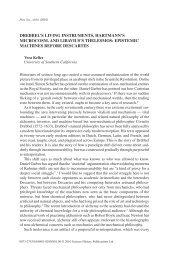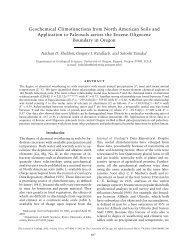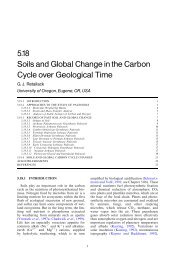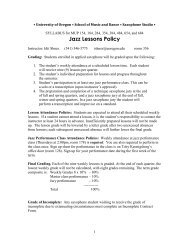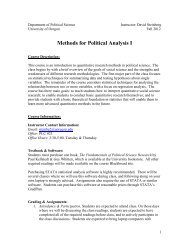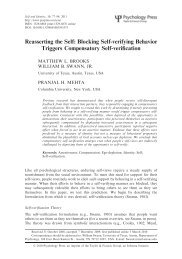Retallack 2007 Proserpina principle - University of Oregon
Retallack 2007 Proserpina principle - University of Oregon
Retallack 2007 Proserpina principle - University of Oregon
You also want an ePaper? Increase the reach of your titles
YUMPU automatically turns print PDFs into web optimized ePapers that Google loves.
planetesimals formed early during the formation<strong>of</strong> the solar system. As primeval soils <strong>of</strong>the solar system, they were similar in theirsmectites, salts, and carbonates to the soils <strong>of</strong>Mars, which are probably paleosols relict froma time <strong>of</strong> free water at the martian surface untilat least 2,500 Ma (<strong>Retallack</strong>, 2001a).A second interpretation <strong>of</strong> carbonaceouschondrites is as primary condensates <strong>of</strong> thesolar nebula. By this view, their hydrolyticalteration is due to melting in cometary nucleiduring close passes with the Sun, or due totransient heating events by shock waves orcollisions (McSween, 1999). Other carbonaceouschondrites show metamorphic alterationwith minerals similar to those in Earthformed during deep burial under elevatedtemperatures and pressures (Brearley, 1999).Like soils and paleosols on Earth and Mars,carbonaceous chondrites demonstrate the greatantiquity <strong>of</strong> hydrolytic weathering in diluteacidic solutions, presumably <strong>of</strong> carbonic acidderived from water vapor and CO 2 . These remainthe principal gases released from volcanoes,and soils remain important buffers forthis environmental acid.5.18.3.2 Archean–PaleoproterozoicGreenhouse PaleosolsDespite predictions that Precambrian paleosolswould be thin, rocky, and dominated byphysical weathering (Schumm, 1956), hundreds<strong>of</strong> Precambrian paleosols now described havebeen found to be thick, clayey, deeply weathered,and in some cases with possible traces <strong>of</strong>life, so that chemical and biological weatheringcan be traced back almost to the beginning <strong>of</strong>the suitably preserved sedimentary rock recordon Earth (Rye and Holland, 2000). The oldestknown pr<strong>of</strong>ile interpreted to be a paleosolshows alteration to depths <strong>of</strong> 50 m on granitesunconformably underlying the 3,500 Ma sedimentarysuccession <strong>of</strong> the Warrawoona Groupin northwestern Western Australia (Buicket al., 1995). Corundum ores in the 3,500 MaAldan Schists <strong>of</strong> Siberia have been interpretedas metamorphosed, deeply weathered bauxites(Serdyuchenko, 1968).The Jerico Dam paleosol <strong>of</strong> South Africa(3,000 Ma; Grandstaff et al., 1986), the Prontopaleosol <strong>of</strong> Canada (2,450 Ma; Mossman andFarrow, 1992), the Hokkalampi paleosol <strong>of</strong>Finland (2,200 Ma; Marmo, 1992), a variety<strong>of</strong> paleosols associated with the HekpoortBasalt <strong>of</strong> South Africa (2,100 Ma; Yang andHolland, 2003), and the Sheigra paleosol <strong>of</strong>Scotland (1,000 Ma; Figures 3 and 4) have beenRecord <strong>of</strong> Past Soil and Global Change 9subjected to exceptionally detailed geochemicaland petrographic analyses. Along with manyother Precambrian paleosols reviewed by Ryeand Holland (1998), these paleosols revealthe antiquity and thoroughness <strong>of</strong> hydrolyticweathering during the Precambrian. Eventhen, rock and sediment were under relentlessacid attack, which leached base cations (especiallyCa 2 þ ,Mg 2 þ , and Na þ ), and left thick,clayey soil.It is likely that at least back to 3,500 Ma, theprincipal environmental acid driving this hydrolyticreaction was carbonic acid dissolved inrain and groundwater (Holland, 1984), as is thecase in soils today (Nahon, 1991). Much soilCO 2 may also have come from respiring organisms,which also could have contributedorganic acids. Nitric and sulfuric acid mayhave been locally important in soils developedon particular parent materials, but nitrogenand sulfur salts are so far unreported in Precambrianpaleosols, unlike modern soils <strong>of</strong>mine dumps (Borden, 2001), and hypothesizedmodern soils on Mars (Bell, 1996; Farquharet al., 2002) and Venus (Barsukov et al., 1982;Basilevsky et al., 1985).This view <strong>of</strong> the likely acids involved in formingPrecambrian soils on Earth is supportedby the isotopic composition <strong>of</strong> carbon, nitrogen,and sulfur in sedimentary organic matter,carbonates, sulfates, and sulfides, which aresurprisingly similar to their modern counterpartsback to 3,500 Ma, and unlike meteoriticor mantle values (Schidlowski et al., 1983; DesMarais, 1997; Canfield and Teske, 1996).Evidence for life in Precambrian soils comesfrom isotopic studies <strong>of</strong> organic carbon withinpaleosols. Microlaminated chips in the 2,765Ma Mt. Roe paleosol <strong>of</strong> Western Australiahave extremely depleted carbon isotopic compositions(d 13 C org 40%). Isotopic fractionation<strong>of</strong> carbon to this degree is only known inmethanogens and methanotrophs (Rye andHolland, 2000). These chips could be fragments<strong>of</strong> pond scum rather than a true soil microbiota.Organic matter in the 2,560 Ma Schagenpaleosols <strong>of</strong> South Africa is not nearly as depleted( 16% to 14% d 13 C org ) as organicmatter in overlying marine sediments ( 35% to30% d 13 C org ). Interpretation <strong>of</strong> the carbon inthis paleosol as the signature <strong>of</strong> a hypersalinemicrobial soil community is compatible withshallow dolocretes and other features <strong>of</strong> thepaleosols (Watanabe et al., 2000).Normal isotopic values for soil organic matter( 25% to 27% d 13 C org ) have been reportedfrom Precambrian paleosols as well(Mossman and Farrow, 1992; <strong>Retallack</strong> andMindszenty, 1994). Virtually all Precambrianpaleosols have a very low content <strong>of</strong> organic



